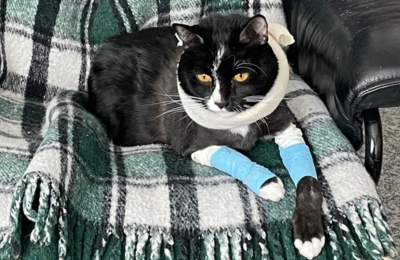More than six years after a yellow Labrador puppy named Maggie underwent a procedure with Arthrex innovation to resolve severe joint pain in her leg, her long-term results have proved both insightful and impressive to her surgeon.
“Typically, once a problem is resolved, we only hear from patients in the long term if there is an issue,” said Mark Rochat, DVM, MS, Section Chief of Small Animal Surgery at Purdue University’s College of Veterinary Medicine. “But in Maggie’s case, her owners have been diligent about providing annual updates on her progress after surgery, so we’ve been able to see how well she’s fared over time.”
 Todd and Marilyn Bowen from Fort Wayne, Indiana, first brought Maggie to see Dr. Rochat in the fall of 2015 when they noticed her limping due to what seemed to be pain in her right hind leg.
Todd and Marilyn Bowen from Fort Wayne, Indiana, first brought Maggie to see Dr. Rochat in the fall of 2015 when they noticed her limping due to what seemed to be pain in her right hind leg.
“Maggie was just eight months old at the time and usually very energetic and playful,” said Todd. “It was hard to watch her in such discomfort and struggling to walk.”
Through an orthopedic examination and an X-ray, Dr. Rochat identified the cause of Maggie’s pain as osteochondritis dissecans (OCD) of the knee. OCD is an inflammatory condition that occurs when diseased cartilage separates from the underlying bone, typically in the joints of rapidly growing large dog breeds between six and nine months of age.
“For reasons we don’t fully understand, the cartilage fails to develop normally into bone, growing thicker than usual; the cartilage then becomes unhealthy and cracks with standard activity, leading to pain and osteoarthritis,” said Dr. Rochat. “This was the case for Maggie.”
Mild forms of OCD may resolve with conservative management, including restricted activity and anti-inflammatory therapy, but in most cases where lameness and pain persist, open surgical or arthroscopic treatment and/or debridement is recommended. One of the newest advancements in the treatment of OCD is synthetic resurfacing of the joint using implants, such as the SynACART® synthetic allograft system, to fill the defect caused by the OCD lesion. The implant consists of a smooth polymer surface that acts as replacement cartilage and a titanium metal backing that allows the bone to grow into and secure the implant.
Dr. Rochat determined the SynACART system was the ideal treatment for Maggie and performed a successful procedure in March of 2016.
 “The SynACART system is very easy to use,” he said. “I like that it’s straightforward and simple, without a complex set of instruments. The result provides a durable, weightbearing surface that seems to mitigate arthritis more effectively than just scooping out the diseased portion of cartilage in the stifle joint.”
“The SynACART system is very easy to use,” he said. “I like that it’s straightforward and simple, without a complex set of instruments. The result provides a durable, weightbearing surface that seems to mitigate arthritis more effectively than just scooping out the diseased portion of cartilage in the stifle joint.”
After about eight weeks of postoperative at-home rest, Maggie returned to her normal self, running in the yard, playing fetch and retrieving Todd’s socks and the Sunday newspaper. Today, she is seven years old with full range of motion and no discomfort; a recent X-ray showed very little arthritis.
“We are so grateful her surgery went well and that even several years later, she remains healthy and happy,” said Marilyn. “We love her dearly, and she is part of our family in every way.”
Dr. Rochat added, “To see Maggie doing so well after this length of time demonstrates the longevity and reliability of the Arthrex SynACART implant. As a surgeon, this gives me added confidence in the product, knowing my patient’s quality of life is improved for the long term.”






